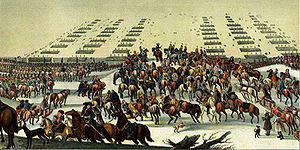- March across the Belts
-
Second Northern War
Theaters"Swedish Deluge" – Russo-Swedish (1656–1658) – Pomerania – Dano-Swedish (1657–1658) – Dano-Swedish (1658–1660) – Norway
BattlesUjście – Danzig – Sobota – Żarnów – Cracow – Nowy Dwór – Wojnicz – Jasna Góra – Gołąb – Warka – Kłecko – 1st Warsaw – 2nd Warsaw – Dyneburg – Kokenhusen – Riga – Prostki – Filipów – Chojnice – March across the Belts – Kolding – Copenhagen – Sound – Nyborg Grudziadz
Treaties The crossing of the Great Belt
The crossing of the Great Belt
The March across the Belts was a campaign between 30 January and 8 February 1658 during the Second Northern War where Swedish king Karl X Gustav led the Swedish army from Jutland across the ice of the Little Belt and the Great Belt to reach Zealand (Danish: Sjælland). The risky but vastly successful crossing was a crushing blow to Denmark, and led to the Treaty of Roskilde later that year.
Contents
Background
During the Second Northern War, king Karl X of Sweden was bogged down in his war with Poland, unable to reach a decisive conclusion to the hostilities despite taking Warsaw. A way out was provided when king Frederick III of Denmark declared war on Sweden. The Swedish army could now march from Poland to the western and central parts of Denmark without making it look like a rout and without having to return to Sweden and then fight its way through then-Danish Scania. Forced marches, amounting to several tens of kilometers a day, took 6,000 Swedish soldiers to Jutland. The army wasn't large but these soldiers were some of the best equipped and trained troops Europe had seen until then. The army swept away the Danish resistance; no one dared to commit to a pitched battle with the "invincible" Swedes.
On 25 August 1657, the Swedish army stood before the newly completed Danish fortress Fredriksodde on Jutland's east coast. The fortress had a complement of about 8,000 men. This fortress did not exist in 1645 (the last time Karl had been there). Fredriksodde was besieged by general Karl Gustav Wrangel for two months, and then stormed on the night of 24 October. Few Swedes perished and 6,000 Danes were captured. In addition, the Swedish army now had all of the Jutland army's supplies.
All of Jutland was soon under Swedish control and the king started preparations for an attack against the Danish islands. In the middle of December the weather shifted, turning into the coldest winter in memory. The seawater between the islands froze, making a ship-borne assault impossible. Engineer Erik Dahlberg was dispatched by the king to ascertain whether the ice would support the weight of the Swedish cavalry and artillery. Dahlberg reported that a crossing over the ice was feasible.
Crossing
 The crossing of the Great Belt
The crossing of the Great Belt
Early in the morning of 30 January 1658, the army was lined up to cross the Little Belt to reach Fyn. The army consisted of about 9,000 cavalrymen and 3,000 foot soldiers. The ice warped under the weight of the soldiers; on occasions water reached up to the men's knees. Close to the shore of Fyn a skirmish broke out with about 3,000 Danish defenders, but these were brushed aside quickly and the army was safe on Fyn.
Now investigations were made to find the best way over the ice that covered the Great Belt in order to reach Zealand. Again Erik Dahlberg led the investigation, and he advised taking the longer route via Langeland and Lolland rather than the more direct route across the Belt. The night of 5 February the king set off with the cavalry across the ice and safely reached Lolland later in the day. The infantry and the artillery followed the next day. Thus, on 8 February, the Swedish host was safely on Zealand, and on 15 February, after forced marches, it reached the outskirts of Copenhagen. The Danes, who had thought the Swedes would start their offensive in the spring at the earliest, panicked and yielded. Negotiations were started and on 26 February the Treaty of Roskilde was signed by the two parties.
Aftermath
The march across the Belts was a risky gamble entirely to King Karl's liking. The news of the victory spread quickly; it was an achievement that drew admiration all over Europe. For Denmark, the outcome of the treaty of Roskilde was disastrous: the entire eastern part of the country (Scania) was ceded to Sweden, and Denmark's existence as an independent state lay in doubt.
Bibliography
- (Swedish) Herman Lindqvist, När Sverige blev stormakt. Stockholm: Norstedt, 1996. ISBN 9789119321121.
- (Danish) Kjeld Hillingsø: Broderstrid: Danmark mod Sverige 1657-60. København: Gyldendal, 2009. ISBN 9788702078992.
Categories:- Second Northern War
- Northern Wars
- 1658 in Denmark
Wikimedia Foundation. 2010.
